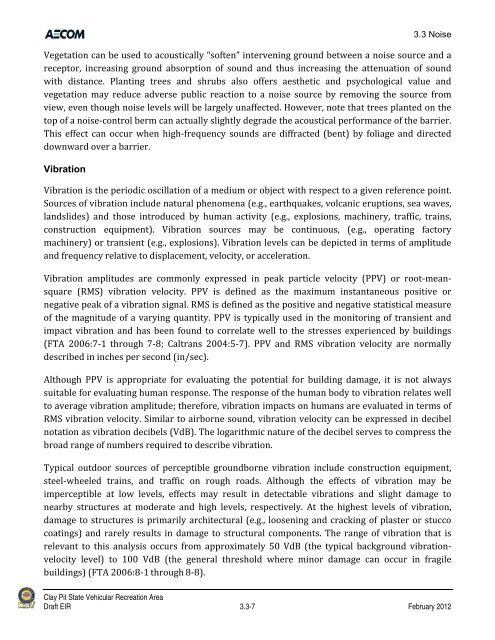Draft Environmental Impact Report - California Off Highway Vehicle ...
Draft Environmental Impact Report - California Off Highway Vehicle ...
Draft Environmental Impact Report - California Off Highway Vehicle ...
You also want an ePaper? Increase the reach of your titles
YUMPU automatically turns print PDFs into web optimized ePapers that Google loves.
3.3 Noise<br />
Vegetation can be used to acoustically “soften” intervening ground between a noise source and a<br />
receptor, increasing ground absorption of sound and thus increasing the attenuation of sound<br />
with distance. Planting trees and shrubs also offers aesthetic and psychological value and<br />
vegetation may reduce adverse public reaction to a noise source by removing the source from<br />
view, even though noise levels will be largely unaffected. However, note that trees planted on the<br />
top of a noise‐control berm can actually slightly degrade the acoustical performance of the barrier.<br />
This effect can occur when high‐frequency sounds are diffracted (bent) by foliage and directed<br />
downward over a barrier.<br />
Vibration<br />
Vibration is the periodic oscillation of a medium or object with respect to a given reference point.<br />
Sources of vibration include natural phenomena (e.g., earthquakes, volcanic eruptions, sea waves,<br />
landslides) and those introduced by human activity (e.g., explosions, machinery, traffic, trains,<br />
construction equipment). Vibration sources may be continuous, (e.g., operating factory<br />
machinery) or transient (e.g., explosions). Vibration levels can be depicted in terms of amplitude<br />
and frequency relative to displacement, velocity, or acceleration.<br />
Vibration amplitudes are commonly expressed in peak particle velocity (PPV) or root‐mean‐<br />
square (RMS) vibration velocity. PPV is defined as the maximum instantaneous positive or<br />
negative peak of a vibration signal. RMS is defined as the positive and negative statistical measure<br />
of the magnitude of a varying quantity. PPV is typically used in the monitoring of transient and<br />
impact vibration and has been found to correlate well to the stresses experienced by buildings<br />
(FTA 2006:7‐1 through 7‐8; Caltrans 2004:5‐7). PPV and RMS vibration velocity are normally<br />
described in inches per second (in/sec).<br />
Although PPV is appropriate for evaluating the potential for building damage, it is not always<br />
suitable for evaluating human response. The response of the human body to vibration relates well<br />
to average vibration amplitude; therefore, vibration impacts on humans are evaluated in terms of<br />
RMS vibration velocity. Similar to airborne sound, vibration velocity can be expressed in decibel<br />
notation as vibration decibels (VdB). The logarithmic nature of the decibel serves to compress the<br />
broad range of numbers required to describe vibration.<br />
Typical outdoor sources of perceptible groundborne vibration include construction equipment,<br />
steel‐wheeled trains, and traffic on rough roads. Although the effects of vibration may be<br />
imperceptible at low levels, effects may result in detectable vibrations and slight damage to<br />
nearby structures at moderate and high levels, respectively. At the highest levels of vibration,<br />
damage to structures is primarily architectural (e.g., loosening and cracking of plaster or stucco<br />
coatings) and rarely results in damage to structural components. The range of vibration that is<br />
relevant to this analysis occurs from approximately 50 VdB (the typical background vibration‐<br />
velocity level) to 100 VdB (the general threshold where minor damage can occur in fragile<br />
buildings) (FTA 2006:8‐1 through 8‐8).<br />
Clay Pit State Vehicular Recreation Area<br />
<strong>Draft</strong> EIR 3.3-7 February 2012








